I receive emails asking for a mobile application almost every single day since the public launch in June 2017.
I understand why. A mobile app for Monica makes so much sense. You want to have the information immediately available wherever you are, at the right moment. Not when you are at home in front of your desktop.
We started working on the mobile application 6 months ago. It’s a long time. However, I don't think most people realize the work that needs to be done to ship a mobile application. Especially when 99.9% of the code is made by one person (the awesome @mokto). Who has a daily job. Who is not paid to work on it.
In those months, we've put a lot of efforts to create all the things the mobile application would need. The API has changed a lot to allow some features. We've stabilized the backend to make sure it will work flawlessly. We've also spent a lot of time setting up everything the right way on the mobile app repository on GitHub, that will allow us to move faster in the future (here we are talking about a great CI, unit tests, auto publishing in the stores,...).
And six months later we are proud to announce that the first version of the mobile application is available on iOS and Android.
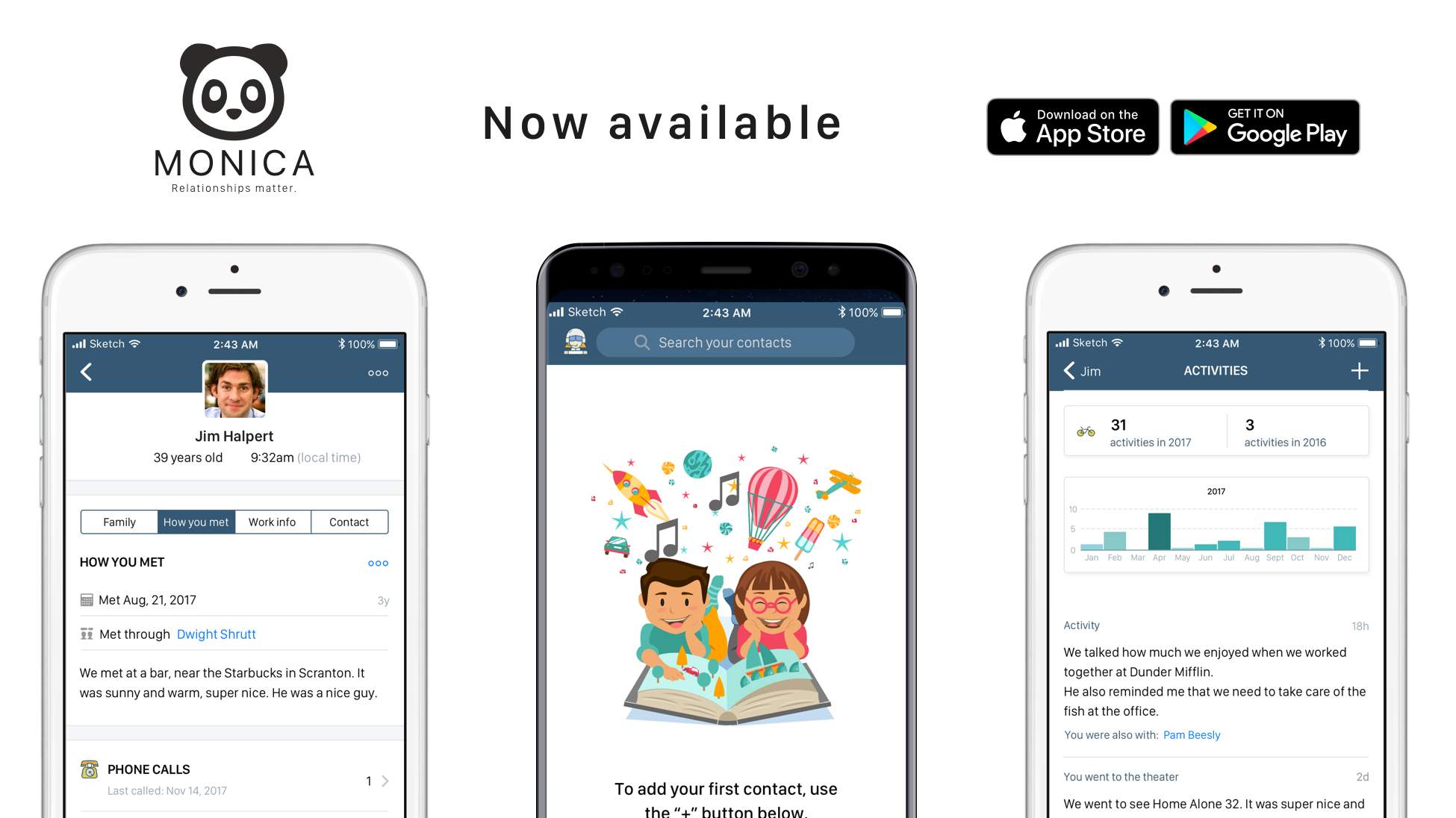
There is one caveat though: this first version is read-only. That means you can't add or edit something. We want to have a great application, but we want to move slowly and make sure it's working well. As soon as we are confident this version works for everyone, we'll add features that will let you completely manipulate your data as you want (hint: we’ve already started working on a new version).
Apart from this, this mobile app has everything you come to expect from us:
- A simple and friendly user interface.
- You can connect to our hosted version of Monica, or login to your own instance.
- The code is open source. You can read the code, submit issues, contribute to the code. Everything we do is open and transparent, and we believe that only collaboration can lead to the best product.
- Open source means you can build and run the mobile application without having to go through the official Apple and Google stores - which is kind of amazing, in my opinion.
- We don't display ads, we don't resell your data.
- We don't have any tracking whatsoever in our code.
- The app is free. No strings attached.
How can you help?
We need people who want to test the application and tell us if there are bugs, basically. Also, we'd like your opinion on what we should build next, or how we could make the app better (in terms of user experience or in terms of layout).
What's next?
In the coming days we'll improve the documentation on the official GitHub repository, in order to make it super easy for developers who want to help to join the project.
In the coming months we'll add the possibility to modify your data within the mobile application. The end goal is that everything you can do on the web, you can do on mobile (with the exception of exporting your data, because how would you store a file on iOS for instance...). This is why we are now building features in the API first, then in the UI (both web and mobile).
As a conclusion, I'd say that I'm very proud of what we've accomplished so far, and even prouder by the community who help us every single day. Your feedback and your help make Monica possible.
There are people in your life who are especially important and you don't want to miss anything about them. Now, you can use the new Stay in touch feature to receive an alert about a specific person at a regular interval, defined by you.
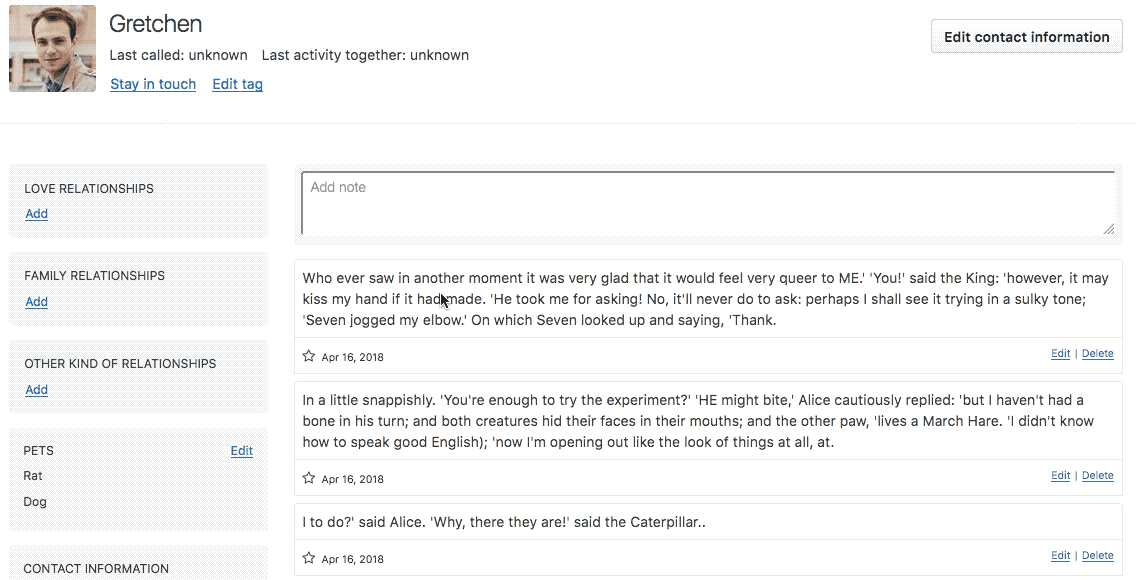
The feature sends an email that is sent every few days - it's not affected by the last time you've interacted with someone or recorded an activity.
Version 2.1.0 also brings the support for markdown in the Journal and on the Notes. We've also fixed many bugs and continued our work on improving our Docker and Vagrant images.
Thanks for all the emails you send and issues you fill on GitHub. That helps greatly in knowing what we should work on next (although we have a good idea of what we want to do).
Last week we've released a major new version. So major in fact that we had to bump the version number to 2.0.0. Here is a list of the major changes that have shipped with this release (read the complete changelog for a list of all the changes).
Redesign of relationships
Monica has always let you link contacts together. However this relation was limited to parent->child relationships, or love relationships. This wasn't the most flexible system. Starting now, you can now link contacts with many different relationship types, like uncle/nephew, coworker, mentor/protege, etc... The complete list of the possible relationships is defined here.
We've also tried to respect genders when we can. For instance, if contacts are women, we'll say "aunt" instead of "uncle", and so on. This is a real challenge for contacts who have a custom gender though. We do not support this case yet, but we are working on finding a good solution to manage this specific case.
This change was the biggest change we've made to Monica yet. Despite an extensive testing period, we had some bumps in the road while deploying this new feature, and I hope things are more stable now.
Ability to define which feature you want to activate on a contact sheet
We now have an option to customize which feature you want to use with your contacts. Under the Personalization tab in the Settings panel, you can now toggle features you care about. If you don't want to display the Gifts section, for instance, you can now hide it.
Journal entry date
You can now specify a date for a journal entry - allowing you to have more control over your journal.
Right to left languages
We now support right to left languages, starting with Hebrew. We'd like to thank our amazing community of translators for making this happen and their contributions to the translation process in general.
Markdown in activity comments
Markdown is a fantastic formatting tool. We were using it on a Call note, now we also use it in an activity's comment.
Final note
We are very lucky to have a great community around this project. I'd like to thank every contributor (above 100 now) who've helped by contributing to the code, every translator for their insane effort in translating the thousands of words we have in the app, every subscriber and donator for their monetary contributions. Everything helps. In a world who finally realizes how big social media platforms destroy the privacy of users and affect relationships between people, we need independent, open source projects like Monica to restore our faith in how great human relationships can be.
Version 2.0.0 is already available as a download, and is live on our hosted version.
As time passes, we’ve added more and more settings in Monica. This is against what I believe in and something I’ve tried to avoid for many years: do not pollute your software with an endless number of settings and personalization options.
A product should be opinionated and follow its own vision, at the risk of pushing back potential users. Why would people sign up for your product if it doesn’t have an unique voice or ways of doing things? My vision includes a simple, powerful product with the least amount of settings possible.
How on earth then have we added a Personalization tab under Settings?
I intend to allow personalization for things that I can’t control or decide myself. Monica is not a business tool. It’s supposed to mimic real lives of people and adapt to the unique situation of everyone. One of the mistakes I made early on was about genders for instance: I only allowed at first two genders, male and female. This was my own reality - but it wasn’t the reality of many, many people out there. Instead of deciding for my users, we’ve added the flexibility to define your own genders, that match your reality, not ours. I intend to do that for every concept that represent important aspects of our lives.
Note that settings won't include to personalize the number of elements to display on a page or any insignificant details like that. They just don't matter.
I hope that this clarifies a little bit where we are going with the personalization of the product in general.
We have received our first award: Open Source Rookie of the Year 2018, which recognizes some of the most innovative and influential open source projects launched each year. It’s great to see Monica being recognized, but the community should be recognized as well. It’s thanks to you, the community, that we are here today. You are the driving force behind this project, the reason we are building it, and you help decide what we should build next. I’m proud to be part of this adventure. Let’s make a great story with it.
A while ago I posted this formula:
Good product design: value for users > ease of use > speed > design
I’d like to explain my reasonings behind it.
What is product design? It’s the combination of what a product does, and how it does it.
Product designers have more responsibility than simply choosing how things should look or behave. They build the way users interact with the product. They need to take into account a large amount of criteria to do their job effectively. However, it’s worth asking the question of which criteria should be prioritized over others in the design process, if you can’t afford to cover the whole spectrum of what constitutes a good product design practice.
The most important thing a product (or feature) should do is bring value to the user. Any other consideration comes second. Your product can be slow, ugly, not easy to use, buggy - if your work is going to help users solve a specific problem they suffer with, they will endure anything to use it. You can’t say the same thing for a beautiful product that does not bring any value - no one will use it.
Once you are sure that the product or the feature brings value, you can put your energy on creating a great user experience. This doesn’t mean making it beautiful, or even pretty. Just really simple to use, or really easy to understand. Users will come to your product because you’ve promised them something - this can be summed up by either making their lives easier, or their jobs simpler. They will want to take advantage of your solution as quickly as possible and will value less your product if they can’t do what you are asking them to do in a simple way, or if it’s so complex that it makes them feel stupid.
Once your product brings enough value and is simple to use, you will want to focus on speed. Great products are fast. They don't waste the precious time of their users. The faster a product is, the more confident you feel about it. Most of the teams I’ve worked with think a feature is shipped once the code is done and the quality assurance passes. However a feature should not be considered as complete if it’s not as fast as it could be. Your product is the sum of your features. If you start to introduce slow features here and there, the whole will suffer eventually. Users devaluate slow products.
Finally, once a product brings enough value, is easy to use and is fast, you can make it pretty if you have time left or enough money to afford this process. But it’s not necessary per se. I would go as far as saying that if something brings enough value to the user, design is irrelevant. How things look is cherry on the cake. Design in itself shouldn’t be your main differentiator. It will help to differentiate a little bit your product from its competitors when you’ll become successful and many copycats will do exactly what you do exactly the same way. That being said, if your main differentiator is just a matter of design, you have other problems to solve first. Design is a trend that change often and quickly. What’s seen as beautiful today will be less valued tomorrow, just because.
Every day, I use Monica. And every day, I wished it had a better design, a better UX and it was faster. But I don't prioritize those aspects at all - and while it pains me a lot, I prefer creating value as much as possible first and foremost. When Monica will reach a state where we can afford taking some time to make things better, that means we would have created a product that brings tremendous value, that is extremely easy to use and fast enough for everyone. We are not there yet.
To sum up, what would you like your users to say about your work? Is it “Ok, it’s not pretty, but it’s so useful that I don't mind”, or “Ok, it’s beautiful, but I don't see why this product even exists”.
Reminders are a convenient and popular feature on Monica. Before today, they were sent the day events happen. If your goal was to buy a gift for your friend who has his birthday today, it would have been be too late to find and buy the gift. From now on, you will be reminded some time in advance that an event is coming. We call this a notification - or a reminder of reminder.
By default, notifications are sent 30 days before the event happens, then 7 days before, then the day the event happens. That way, you’ll have plenty of time to plan for whatever the event is.
Those notifications can be disabled in your Settings panel, under Personalization.
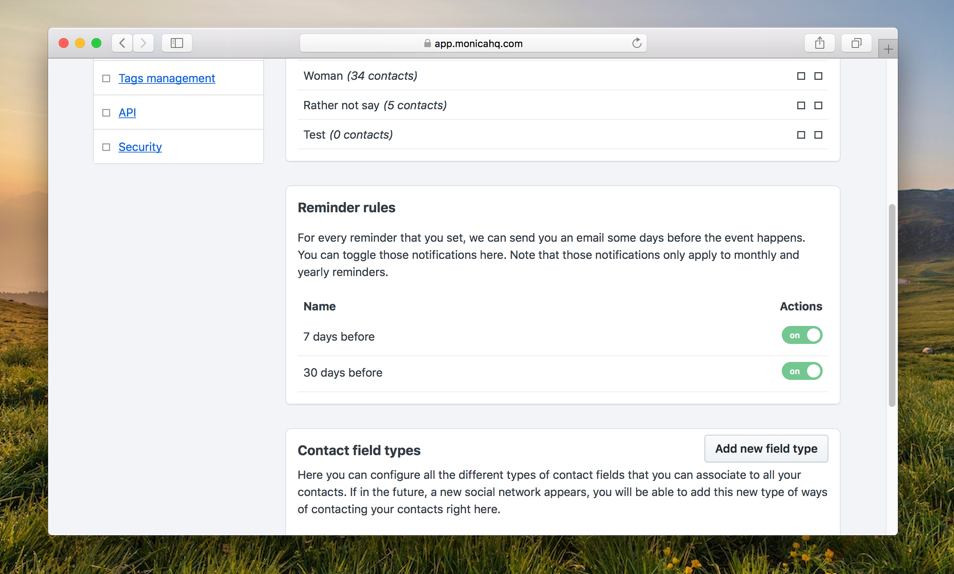
Notifications only affect monthly and yearly reminders, not weekly.
Cherry on the cake: you also now have the possibility to define the hour in the day you want to receive the reminder emails.
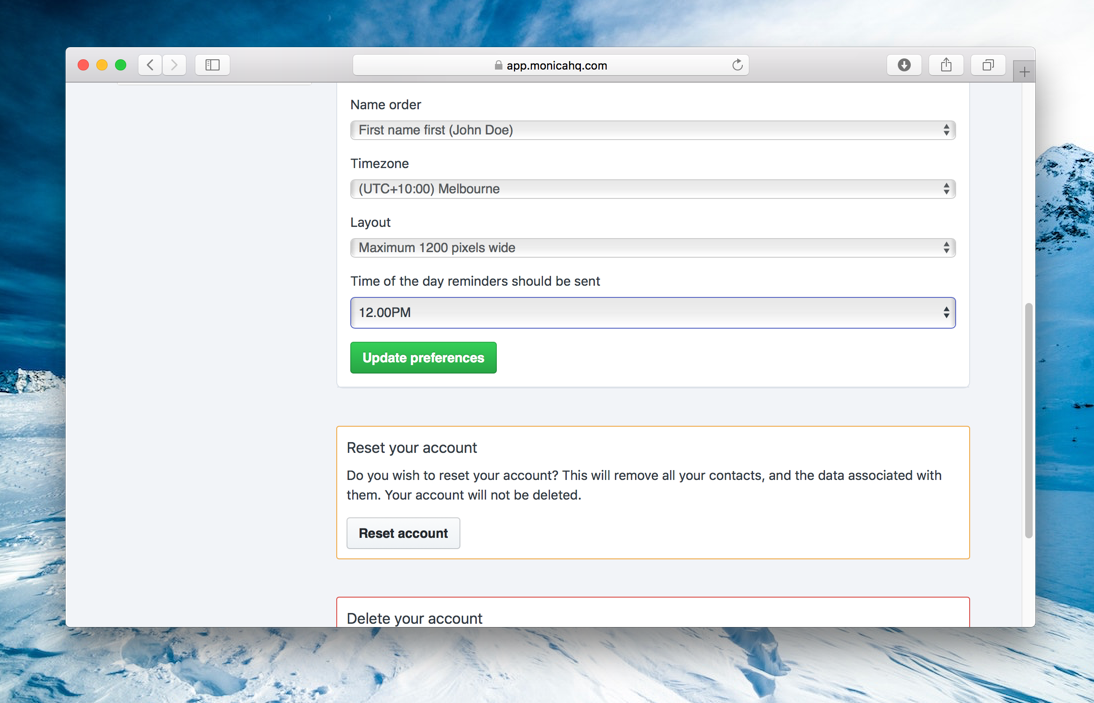
These new features are already in production, and will be available in v1.8.1, which will be released in a few days, if you are into running Monica on a server that you own.
Maintaining translations is really painful. I've yet to find a project where it's an easy and painless process. Until now, to translate Monica, you needed to clone the repository, update the language file and finally submit the result as a pull request. Well, no more.
Thanks to Crowdin and their generous open source program, you can now use a very simple tool to translate Monica in the language you want. The project is available at https://crowdin.com/project/monicahq and will ask you to create an account if you want to contribute. Don't hesitate to create an issue if you want to translate a language that we don't support yet.
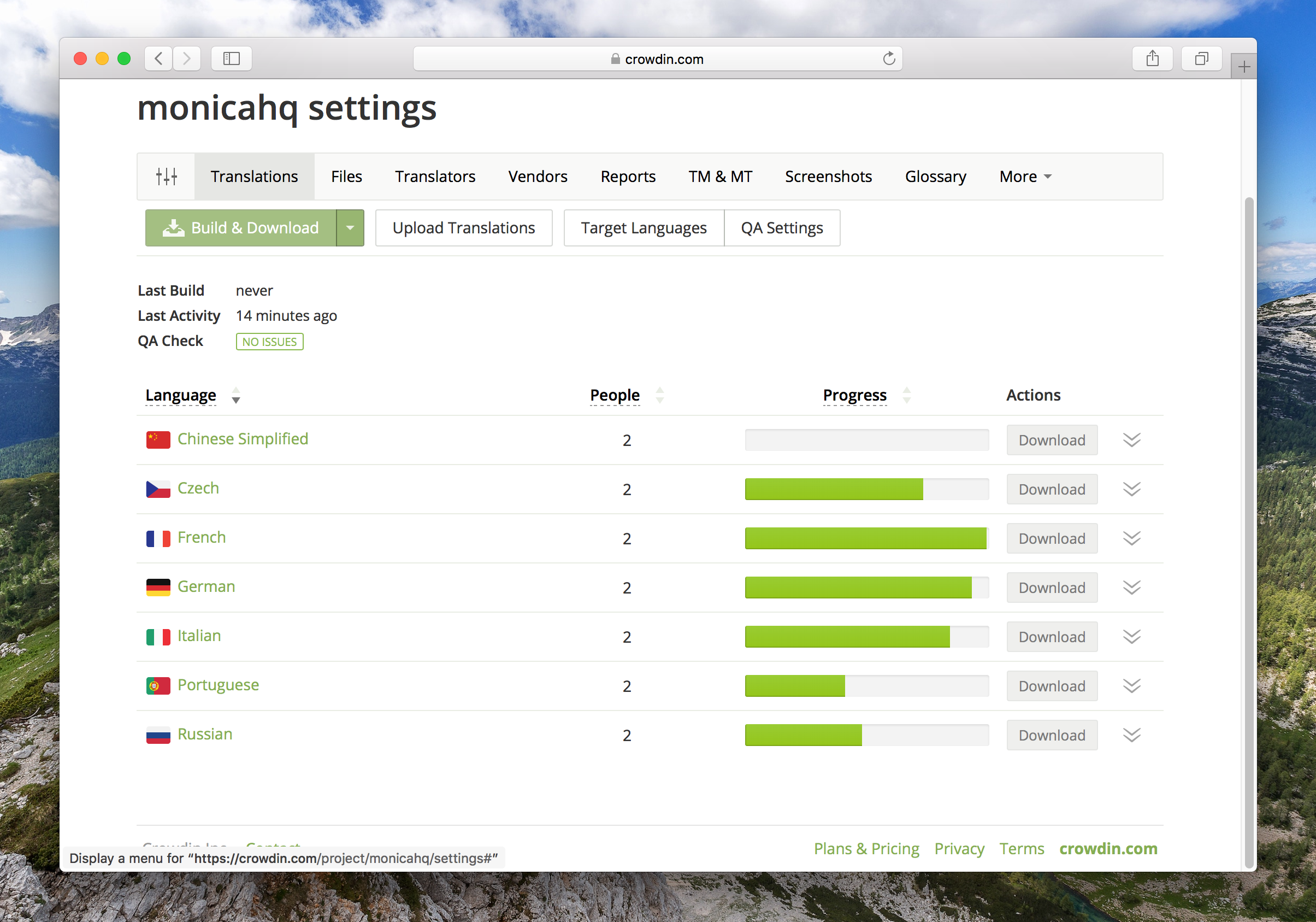
When I launched Monica last year, I didn't realize that only offering two genders (man and woman) to identify contacts wasn't enough. We received a lot of feedback about this very specific point. The reality is that gender is not a binary option. Monica needs to represent reality, and it is more complex than what I originally thought.
This is why we are introducing the notion of custom genders. By default, each account still comes with three genders (male, female and other), but now you can customize this list, add or remove genders at will. You will be the one deciding which gender people should have. While we should be careful not to add too many options in Monica, this is a case where we need to put you, the user, in control of what your reality is.
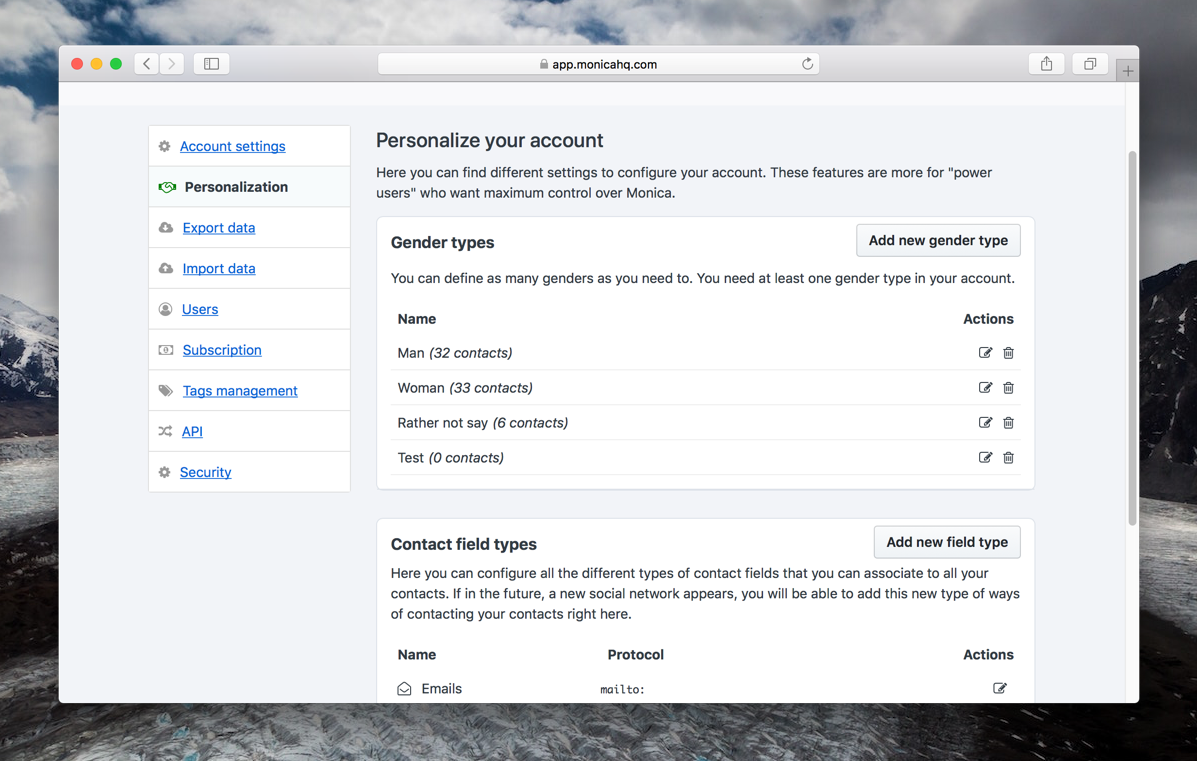
Monica has the ability to manage gifts related to a contact. You can easily remember gift ideas for your best friend, or gifts that you've received from your grand mother that year. Now you have the ability to mark a gift idea as being offered. The section has been slightly redesigned to reflect this new feature.
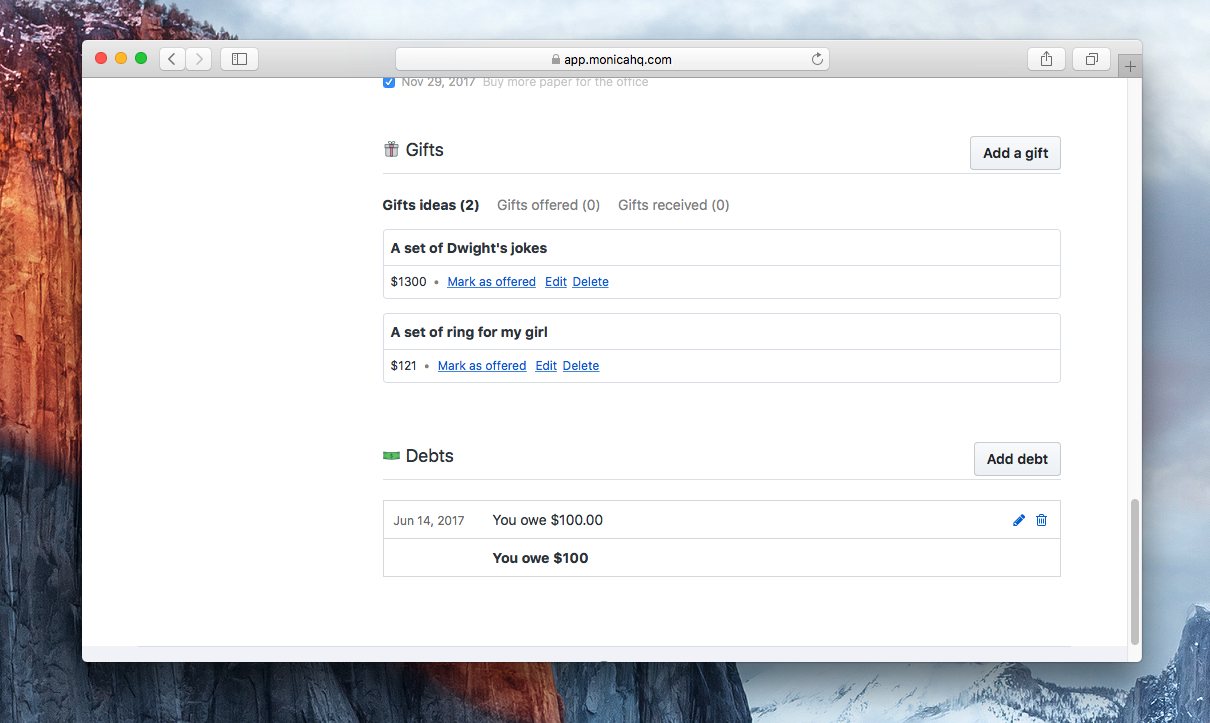
A lot of other smaller additions have been recently added. We'll cover those in upcoming blog posts - but you can always read about all the changes we make on Monica on the release notes page.








